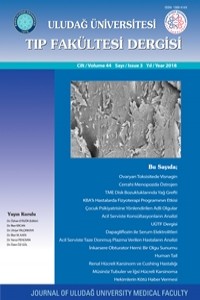Abstract
“Human tail”; lumbosakrokoksigeal
kaudal bölgede, üzeri cilt ile kaplı protrüzyon olarak gözlenen, nadir görülen,
konjenital, embriyonik, vestigial benign bir anomalidir. Klinik, radyolojik,
histopatolojik incelemelerle “true tail” ve “pseudo tail” olarak birbirinden ayırd
edilmeleri gerekir. Özellikle radyolojik incelemeler preoperatif dönemde bu
ayrıcı tanıyı yapmakta büyük öneme sahiptir. Human tail’e diğer konjenital
anomaliler eşlik edebilir, spinal disrafizm bu anomalilerde en büyük paya
sahiptir ki bu da iyi bir klinik yönetim gerektirmektedir. Bu olgu sunumunda,
“true tail” ile doğmuş, sağlıklı bir yenidoğan olgusundan bahsedildi.
References
- 1) Mahesh K. Pillai, Smitha T. Nair. A True Human Tail in a Neonate. Sultan Qaboos Univ Med J. 2017; 17(1): e109–e111.
- 2) Lu FL, Wang PJ. The Human Tail. Pediatr Neurol. 1998;19(3):230-3.
- 3) Dao AH, Netsky MG. Human tails and pseudotails. Hum Pathol. 184; 15(5):449-53.
- 4) Chauhan SP, Gupta A. Human tail with spina bifida. Br J Neurosurg. 2009; 23(6):634-5.
- 5) Turk CC, Kara NN, Bacanli A. The human tail: A simple skin appendage or cutaneus stigma of an anomaly? Turk Neurosurg. 2016; 26(1);140-5.
- 6) Clark P, Davidson L. Case report:pseudotail with dermal sinüs tract and tethered cord. J Ultrasound. 2016; 19(3):239-241.
- 7) Kabra NS, Srinivasan G, Udani RH. True tail in neonate. Indian Pediatr. 1999; 36(7):712-3
- 8) Amirjamshidi A, Abbassioun K, Shirani M. Skin-covered midline spinal anomalies: a report of four rare cases with a discussion on their genesis and milestones in surgical management. Childs Nerv Syst. 2006; 22(5);460-5
Abstract
Human tail is a rare,
congenital, embryonic, vestigial benign anomaly observed as a skin covered
protrusion in lumbosacrococcygeal region. True tail and
pseudotail should be distinguished from each other by clinical, radiological
and histopathological examinations. Particularly
radiological examinations have great importance in making this differential
diagnosis in the preoperative period. Human tail may be accompanied by other
congenital anomalies, spinal dysraphism has the largest share in these
anomalies, which requires good clinical management. In this case report, a
healthy newborn with human tail was mentioned.
References
- 1) Mahesh K. Pillai, Smitha T. Nair. A True Human Tail in a Neonate. Sultan Qaboos Univ Med J. 2017; 17(1): e109–e111.
- 2) Lu FL, Wang PJ. The Human Tail. Pediatr Neurol. 1998;19(3):230-3.
- 3) Dao AH, Netsky MG. Human tails and pseudotails. Hum Pathol. 184; 15(5):449-53.
- 4) Chauhan SP, Gupta A. Human tail with spina bifida. Br J Neurosurg. 2009; 23(6):634-5.
- 5) Turk CC, Kara NN, Bacanli A. The human tail: A simple skin appendage or cutaneus stigma of an anomaly? Turk Neurosurg. 2016; 26(1);140-5.
- 6) Clark P, Davidson L. Case report:pseudotail with dermal sinüs tract and tethered cord. J Ultrasound. 2016; 19(3):239-241.
- 7) Kabra NS, Srinivasan G, Udani RH. True tail in neonate. Indian Pediatr. 1999; 36(7):712-3
- 8) Amirjamshidi A, Abbassioun K, Shirani M. Skin-covered midline spinal anomalies: a report of four rare cases with a discussion on their genesis and milestones in surgical management. Childs Nerv Syst. 2006; 22(5);460-5
Details
| Primary Language | Turkish |
|---|---|
| Subjects | Health Care Administration |
| Journal Section | Case Report Articles |
| Authors | |
| Publication Date | December 1, 2018 |
| Acceptance Date | October 4, 2018 |
| Published in Issue | Year 2018 Volume: 44 Issue: 3 |
ISSN: 1300-414X, e-ISSN: 2645-9027
Creative Commons License
Journal of Uludag University Medical Faculty is licensed under a Creative Commons Attribution-NonCommercial-NoDerivatives 4.0 International License.
2023


